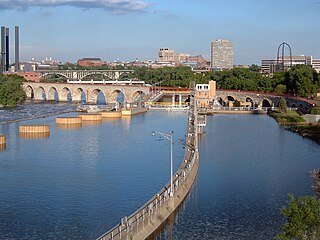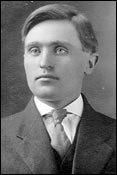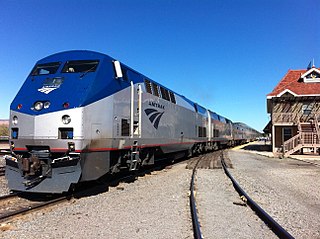
Hibbing is a city in Saint Louis County, Minnesota, United States. The population was 16,214 at the 2020 census. The city was built on mining the rich iron ore of the Mesabi Iron Range and still relies on that industrial activity today. At the edge of town is the world's largest open-pit iron mine, the Hull–Rust–Mahoning Open Pit Iron Mine. It is the hometown of singer-songwriter Bob Dylan and former Governor of Minnesota Rudy Perpich.

Hupmobile was an automobile built from 1909 through 1939 by the Hupp Motor Car Company of Detroit. The prototype was developed in 1908.

Jefferson Lines is a regional intercity bus company operating in the United States. Their operations serve 14 states in the Midwest and West.

Greyhound Lines, Inc. (Greyhound) is a company that operates the largest intercity bus service in North America. Services include Greyhound Mexico, charter bus services, and Amtrak Thruway services. Greyhound operates 1,700 coaches produced mainly by Motor Coach Industries and Prevost serving 230 stations and 1,700 destinations. The company's first route began in Hibbing, Minnesota in 1914 and the company adopted the Greyhound name in 1929. The company is owned by Flix North America, Inc., an affiliate of FlixBus, and is based in Downtown Dallas.

Saint Paul Union Depot is a historic railroad station and intermodal transit hub in the Lowertown neighborhood of Saint Paul, Minnesota. It serves light rail, intercity rail, intercity bus, and local bus services.

The New York Transit Museum is a museum that displays historical artifacts of the New York City Subway, bus, and commuter rail systems in the greater New York City metropolitan region. The main museum is located in the decommissioned Court Street subway station in Downtown Brooklyn and Brooklyn Heights in the New York City borough of Brooklyn. There is a smaller satellite Museum Annex in Grand Central Terminal in Midtown Manhattan. The museum is a self-supporting division of the Metropolitan Transportation Authority.
The Yellow Coach Manufacturing Company was an early manufacturer of passenger buses in the United States. Between 1923 and 1943, Yellow Coach built transit buses, electric-powered trolley buses, and parlor coaches.

An intercity bus service or intercity coach service, also called a long-distance, express, over-the-road, commercial, long-haul, or highway bus or coach service, is a public transport service using coaches to carry passengers significant distances between different cities, towns, or other populated areas. Unlike a transit bus service, which has frequent stops throughout a city or town, an intercity bus service generally has a single stop at one location in or near a city, and travels long distances without stopping at all. Intercity bus services may be operated by government agencies or private industry, for profit and not for profit. Intercity coach travel can serve areas or countries with no train services, or may be set up to compete with trains by providing a more flexible or cheaper alternative.

The Southern California Rapid Transit District was a public transportation agency established in 1964 to serve the Greater Los Angeles area. It was the successor to the original Los Angeles Metropolitan Transit Authority (MTA). California State Senator Thomas M. Rees sponsored the bill that created the RTD, which was meant to correct some deficiencies of the LAMTA, and took over all of the bus service operated by MTA on November 5, 1964. RTD was merged into the Los Angeles County Metropolitan Transportation Authority in 1993.

Transportation in the U.S. State of Minnesota consists of a complex network of roadways, railways, waterways and airports. The transportation system is generally overseen by the Minnesota Department of Transportation, a cabinet-level agency of the state government. Additionally, regional governments such as the Metropolitan Council have authority over regional planning for the transportation system and local governments such as cities and counties oversee the local transportation network.

Viad Corp provides experiential leisure travel and face-to-face events in the United States, Canada, the United Kingdom, Europe, and the United Arab Emirates via two divisions: GES and Pursuit.

The United Kingdom has a number of intercity coach services.
The Great Lakes Greyhound Lines, a highway-coach carrier, was a Greyhound regional operating company, based in Detroit, Michigan, USA, from 1941 until 1957, when it merged with the Northland Greyhound Lines, a neighboring operating company, thereby forming the Central Division of The Greyhound Corporation, called also the Central Greyhound Lines.

Carl Eric Wickman was the founder of Greyhound Lines.

The United States is serviced by a wide array of public transportation, including various forms of bus, rail, ferry, and sometimes, airline services. Most established public transit systems are located in central, urban areas where there is enough density and public demand to require public transportation. In more auto-centric suburban localities, public transit is normally, but not always, less frequent and less common. Most public transit services in the United States are either national, regional/commuter, or local, depending on the type of service. Sometimes "public transportation" in the United States is an umbrella term used synonymously with "alternative transportation", meaning any form of mobility that excludes driving alone by automobile. This can sometimes include carpooling, vanpooling, on-demand mobility, infrastructure that is oriented toward bicycles, and paratransit service. There is public transit service in most US cities.
Central Greyhound Lines is a name used in six different contexts or applications in the intercity highway-coach industry in the USA. In each of the first five instances, the name was used for a regional operating company of The Greyhound Corporation. In the last instance, the name was used for an internal administrative department of the (second) Greyhound Lines, Inc., the (second) GLI, a separate, independent, unrelated firm, after the GLI bought the core bus business of The Greyhound Corporation.

Indian Trails, Inc., is an intercity bus operator primarily serving the U.S. state of Michigan, with routes also serving Wisconsin and Minnesota. Indian Trails is based in Owosso, Michigan, with offices in Romulus, East Lansing, and Kalamazoo.

The Andrew G. Anderson House is a historic house in Hibbing, Minnesota, United States. It was built in 1920 for Andrew "Bus Andy" Anderson, a pioneer in the intercity bus service industry. The house was listed on the National Register of Historic Places in 1980 for its local significance in the themes of architecture and transportation. It was nominated for its association with Anderson and its status as one of the most lavish residences in the Hibbing area.

The Columbus Bus Station was an intercity bus station in Downtown Columbus, Ohio. The station, managed by Greyhound Lines, also served Barons Bus Lines, Miller Transportation, GoBus, and other carriers. The current building was constructed in 1969. From 1979 until its closure in 2022, with the demolition of Union Station and a short-lived replacement, the Greyhound station was the only intercity transit center in the city.


















